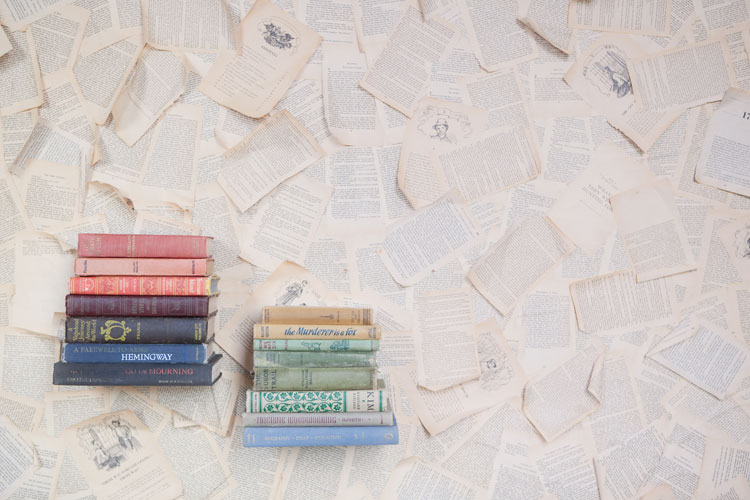
Click for more details
This series of posts started with book wallpaper; now Design*Sponge notes this DIY tutorial on how to make your own. Ruche explains: “We picked up some used cheap paper back books at the thrift store. You don’t necessary need old antique books, just books with pages with a yellow tint. (If you’re wondering, we used Secret Garden, 3 Ninjas, and some other one. haha) We used a paint roller to roll “Sta-Fold” (liquid starch that use for iron clothes) all over the wall, stuck old book papers on wall, and rolled another coat of “Sta-fold”. Work one section at a time. Wait for it to dry..and TADA!”
The D*S post notes the use of this look in a fashion shoot for a clothing brand (below).
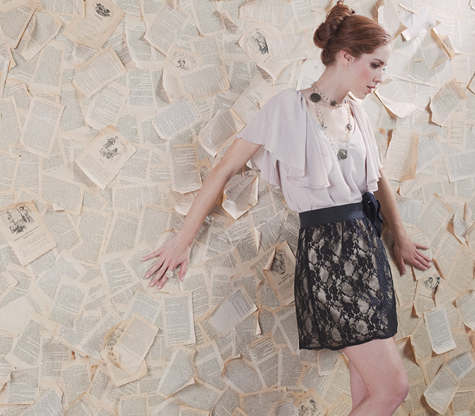
By Stephanie Williams. Click for more details.
Posted Under:
DIYism,
The Designed Life
This post was written by Rob Walker on March 23, 2010
Comments Off on The idea of the book, cont’d: DIY book-page wallpaper
[I’m bringing this back on a Tuesday/Friday basis. Thoughts?]
-
- When Good Companies Choose EVIL Names: “Did the founders of these businesses neglect to do a quick Google search before setting their names in legal stone, or did they hope to capitalize on the intimidation factor of naming their companies after sinister fictional corporations?”
- Green consumers’ dirty little secrets: “New research suggests that those who make “green” purchases are subsequently more likely to behave selfishly, cheat and steal.” Similar: Goodies behaving badly: “Being virtuous is wonderful thing, but feeling virtuous is a shortcut to vice. That seems to be the moral of a fascinating piece of research by two Canadian psychologists, which suggests that the greener people are, the more likely they are to lie and cheat.” Somewhat similar research discussed in Buying In — “the licensing effect.”
- The Digital Surplus and Its Enemies < Columns | PopMatters: Rob Horning reviews Jaron Lanier’s book.
- Raiding Eternity: As part of a series called “Memory Forever,” Gizmodo has a rather fascinating piece of writing by Joel Johnson. It deals with our digital legacies, I guess you could say. His approach is unusual, and made me want to read more of his work. Via Listenerd.
- Product Displacement: Glady Santiago posts a video from an Australian show called Hungry Beast on the topic that she’s been more on top of than anybody. It’s interesting to hear the guy talk about how product displacement (using props that look like a known brand, but aren’t — like UDS instead of UPS; see Santiago’s blog for more) can actually help the real tweaked brand. The idea is that it “engages” the consumer.
- Will Your College Be Covered in Virtual Graffiti?: “Sophisticated new phones can sense their locations, so people are starting to use them to create a new layer of content mapped to specific places on and around campus. These digital sticky notes can share everything from official tours to student mischief.”
- Terra Nova: Virtual Goods at GDC: “Virtual goods now a $6b business. … Rumor that US states will begin charging sales tax on virtual item sales within the year.”
- The revolution was not tweeted – The Irish Times – Sat, Feb 20, 2010: “The Iranian Twitter Revolution meme is thoroughly debunked in Cloud Culture , a new study examining the impact of social media on the way we live our lives. It reports that a third of Iranians have internet access and the number of Twitter users in the country during last June’s unrest amounted to just 0.082 per cent of the population.”
These links compiled via delicious, and repurposed here with plug-in Postalicious. Not enough stuff? Not the stuff you wanted? Try visiting unconsumption.tumblr.com, murketing.tumblr.com, and/or the Consumed Facebook page.
Posted Under:
Non-Daily Linkpile
This post was written by Rob Walker on March 23, 2010
Comments Off on Linkpile
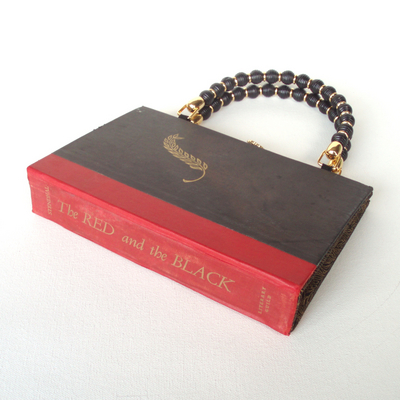
Stendahl's novel as handbag, by Rebound Designs. Click picture for more info.
To go with necklace and ring?
Via Slog, where you can see a wallet made out of a “damaged paperback.”
(Thx: Andrew W!)
Posted Under:
Things/Thinking
This post was written by Rob Walker on March 23, 2010
Comments Off on The idea of the book, cont’d: Converted to purse or wallet

Poppytalk has this: You can order for $59 a batch of interior design materials samples, from desiginabag.com. Stuff in its rawest form. What to do with it when you’re done? Pretty, though.
Posted Under:
Things/Thinking
This post was written by Rob Walker on March 22, 2010
Comments Off on Pictures of Stuff, Cont’d.: Samples
This earlier post linked to work by Jane Mount, but only in passing, and it’s something I wanted to return to. So, here’s something more specific:
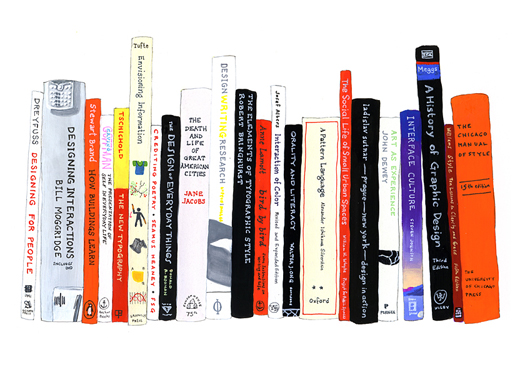
"Early version" of Danzico books portrait by Jane Mount; click for details.
Mount paints “portraits of people’s bookshelves” (or rather, of the book spines on them). In this case she asked Liz Danzico if she could paint a portrait of some of her design books. More info here.
Posted Under:
Artists
This post was written by Rob Walker on March 22, 2010
Comments Off on The idea of the book, cont’d: Ideal bookshelf
[ 3-24-10 Note:Below the jump, there are extensive updates to this post based on comments and other feedback.]
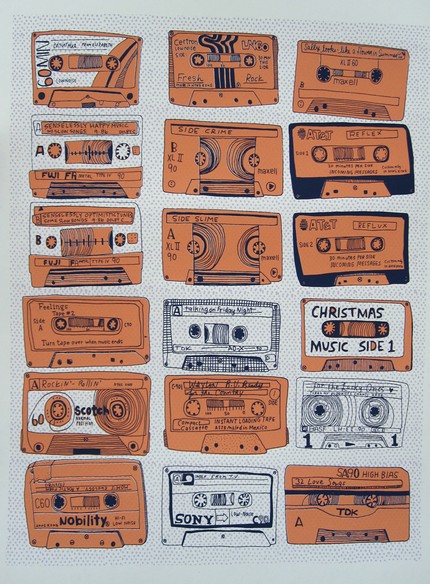
By Kate Bingaman-Burt. Throughout this post, click image for additional details.
In a recent essay for a museum show about music and objects, I made the following rash assertion: “The poor old cassette – cheap, plastic, fragile— enjoys none of the romance associated with vinyl culture.” In retrospect this was a silly thing to say; at the least, I wish I’d said it differently. It’s a different kind of romance, and it certainly isn’t creating anything like the unlikely resurgence in sales of vinyl that’s occurred in the last couple of (https://lakesidepethospitalfolsom.com/tramadol-100mg/) years. But it was flat wrong of me to imply that nobody cares about the idea of the cassette.
I brooded about this for a few weeks and started collecting links and images relating to the various ways that the idea of the cassette persists. I’ve compiled much of that in this massive post, and welcome your (valium) suggestions about examples or useful reading that I’ve missed. Unlike my series of posts on the idea of the book, this will be more of a one-stop approach, like the earlier gallery of default anonymity. That is, I’ll add stuff to this post as I find it, or you tell me about it.
What follows, then, is a bit of a hodgepodge, but I’d really love to hear your thoughts. Do you still have a box of old cassettes somewhere? Do the images here do anything for you? Do you feel any cassette nostalgia?
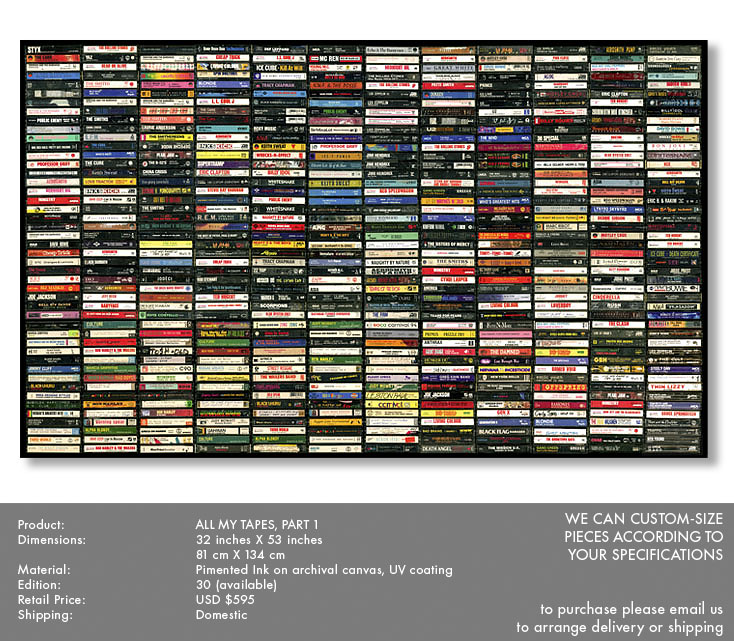
“All My Tapes, Part 1,” by Bughouse
It so happens that smack in the middle of my brooding and link-collecting, Pitchfork published a huge essay setting out to explain the “underground resurgence” of cassettes, citing “a confluence of cultural trends.”
Instant access to almost any recording has left some of us over-stimulated, endlessly consuming without really digesting what we hear. Many children of the 1980s first owned their music on cassette, so for them the format represents a nostalgia for simpler times; younger kids probably never owned cassettes in the first place, so for them tapes don’t have any negative associations. The spread of Internet-enabled smart phones and 24/7 social networking has made work and pleasure increasingly intertwined in our digital existences. Like records, cassettes offer listeners a tangible experience at a time when our jobs, our social lives, and our popular culture are becoming more and more ephemeral.
Noted in the Pitchfork piece is the British cassette-only label The Tapeworm (“No barcodes,” the label’s site announces almost immediately, and that strikes me as a pretty interesting thing to tout as a selling point) and this roundup of 101 Cassette Labels. Wieden + Kennedy’s WKE site recently had a short video feature on a couple of cassette-only labels in Portland.
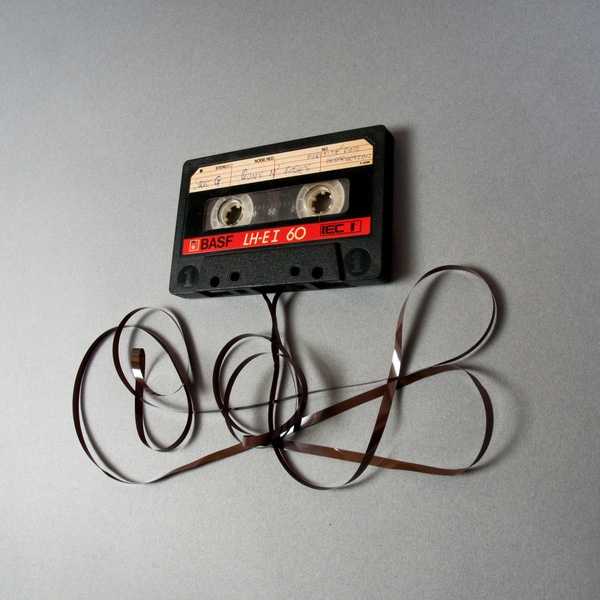
From Andy Sawyer’s “Signs of Use.”
That said, the idea of the cassette, so far as I know, doesn’t have all that much to do with with nostalgia for or connection to the sounds it produced; you can find somebody to tell you vinyl sounds better, but are there advocates of the audio quality of cassettes? Read more
-
- Lord of the Logos: Designing the Metal Underground: “Christophe Szpajdel’s dynamic logo design has helped set a distinct visual tone for heavy metal. Pulling from nature and the art deco, Szpajdel creates strong typographic identities, and with them hordes of fans among the metal faithful.” Thx Cousin Lymon.
- Online Status Anxiety: “The one shared feature that I’m most interested in is also a little disturbing: the tendency of the social software to quantify our social life. Facebook doesn’t just let us connect with our friends: it counts our friends. Twitter doesn’t just allow us to aggregate a stream of chatter: it measures our social reach.”
- Your Computer Really Is a Part of You | Wired Science | Wired.com: Study concludes that Heidegger’s “ready to hand” concept applies to computers. (Ready to hand = “People don’t notice familiar, functional tools, but instead “see through” them to a task at hand, for precisely the same reasons that one doesn’t think of one’s fingers while tying shoelaces. The tools are us.”)
- What Does an Organic Label Mean? » Sociological Images: The specific wording, and where on the package the statement is placed, is an indication of just how “organic” the product might be:
- Where does your dairy come from? Look it up on this website.: As in, what farm it comes from. BB link.
These links compiled via delicious, and repurposed here with plug-in Postalicious. Not enough stuff? Not the stuff you wanted? Try visiting unconsumption.tumblr.com, murketing.tumblr.com, and/or the Consumed Facebook page.

Judith Selby Lang & Richard Lang, click pic for more.
The artists write:
In 1999 we started collecting plastic debris—carrying it away by the bagful— all from Kehoe Beach, a remote stretch of the Point Reyes National Seashore, in Northern California. Certain items would catch our interest: milk jug lids, combs, toy soldiers, disposable lighters, cheese spreaders from lunch snack packs. We were attracted to things that would show by their numbers and commonness what is happening in the oceans around the world.
The plastic we continue to find is not left by visitors; it is washing up from the ocean. Back in our studios we clean, sort and categorize the pieces according to color and kind. We use the plastic to make artworks including large sculptures, installations, photo tableaus and jewelry.
This via the consistently impressive Junk Culture. Does it fit with Joshua Glenn’s “significant objects meme“? I don’t know. Nice connection here though between this work and the activities of Underwater New York, one of our S.O. collaborators.
Posted Under:
Things/Thinking
This post was written by Rob Walker on March 19, 2010
Comments Off on Pictures of Stuff, cont’d.
The Book: Terms Of Service, by Matthew Battles:
I. Privacy
What takes place in the exchange between your brain and the contents of The Book is your exclusive private concern. The Book will never download the contents of your brain, either whole or in part.
II. Intellectual Property
A. The Book often contains ideas and information created by others. The continued appearance of such ideas and information depends on the recognition of a limited property right enjoyed by creators of said ideas and information. But recognizing that the terms of service also require access to ideas and information and the ability to repurpose them in the creation of new works, the creator’s monopoly right shall be understood to be limited and circumscribed.
Continue here. Or check out the video/movie interpretation, here.
I have a feeling David Shields would be particularly into this, no?
One more bit I have to quote, given the nature of this site:
V. Special Provisions
A. The Book will not place ads in your brain, nor seek to control placement of such ads by others.
Posted Under:
Pleasing
This post was written by Rob Walker on March 18, 2010
Comments Off on The idea of the book, cont’d.
I love this. If you’re into Tumblr at all, you basically just enter the Tumblr name into the box and voila, as they say. Here’s the Tumbler mosaic for Things That Look Like Other Things. And one for Counterfunctionality: A Gallery. And for MKTG.
Imagine what you’ll see when you enter the names of Tumblrs that are actually good??
Via: Suicedewatch, but before you click on the link, know that much of what’s posted there is NSFW.
Posted Under:
Pleasing
This post was written by Rob Walker on March 18, 2010
Comments Off on Tumblr Mosaic Viewer
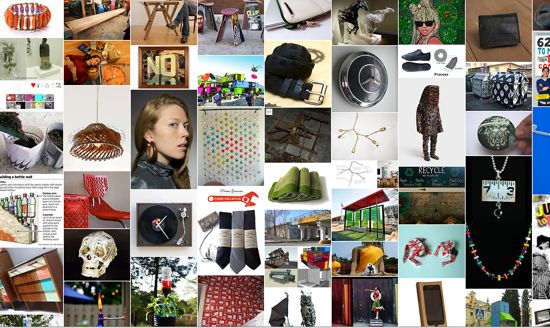
As many of you already know, the Unconsumption Tumblr is a team effort involving several volunteer contributors. There’s me, of course, but also Steve Chaney, Tom Hosford, and Brian W. Jones. Two of the other participants, Amy Shaw and Andrew Whitelaw, had to drop out a few months back (which is totally understandable — everybody has a lot to do), and I’ve been meaning for a while to offer an invitation here:
If you know/like the Unconsumption Tumblr and want to join the team of contributors, drop me a line. Part of what makes the project fun for me isn’t just having yet another venue to put stuff out there, but also being surprised by what others find/encounter/post. I’d particularly love to hear from anybody who stays on top of the various eco blogs better than I do. (Side comment: For a visual taste of what we’ve been posting over the past year or so, check out using this Tumblr mosaic-viewer link. That’s a tool I just learned about this morning — very cool!)
On a related note, I’ve also been meaning to put out an open call for help on the related Unconsumption Wiki — that could definitely use some oversight and involvement by somebody with much better social-media-fu than I personally possess. We’ve had a bunch of people sign up (30 or 40 I think) but only a handful have contributed so far. So, yeah, some help there would be great if you have ideas.
–> If you’re interested in either please drop me a line at murketing [AT] robwalker [DOT] net. (It may take me a day or two to respond, but I will.)
In general the Tumblr links to and highlights stuff we find interesting, useful, admirable, or provocative, that’s somehow related to the unconsumption idea. Part of being a contributor is helping shape what that means, and where it goes. For those of you not familiar with this idea, here’s a quick recap of Unconsumption: Read more
For those who recall this earlier post about my interest in color-bar test pattern riffs:
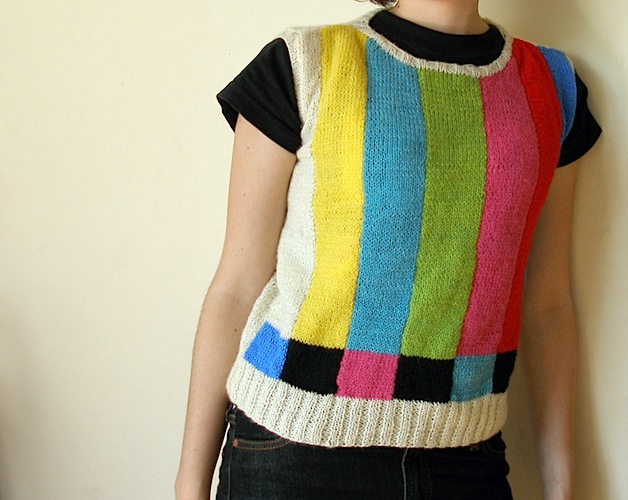
Via Craftzine. Click pic for details.
Posted Under:
The Designed Life
This post was written by Rob Walker on March 17, 2010
Comments Off on Stand by, continued
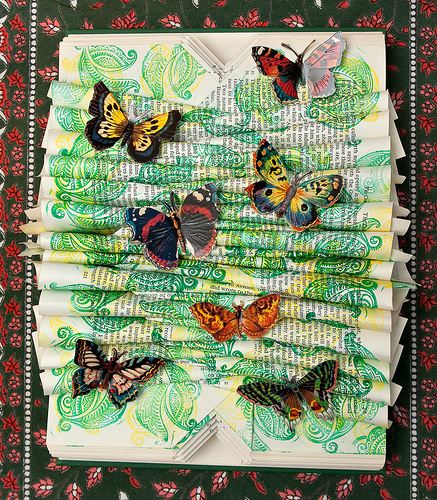
Rachel Ashe; click picture for details.
James informs me of Rachel Ashe’s “altered book” works. The materials list for this one includes glue, rubber stamp and ink, and “book.”
Posted Under:
Artists
This post was written by Rob Walker on March 17, 2010
Comments Off on The idea of the book, cont’d.

I really have no information on this, at all.
Posted Under:
Things/Thinking
This post was written by Rob Walker on March 16, 2010
Comments Off on Pictures of Stuff, cont’d.
In all cases, you can click on the image for more info:
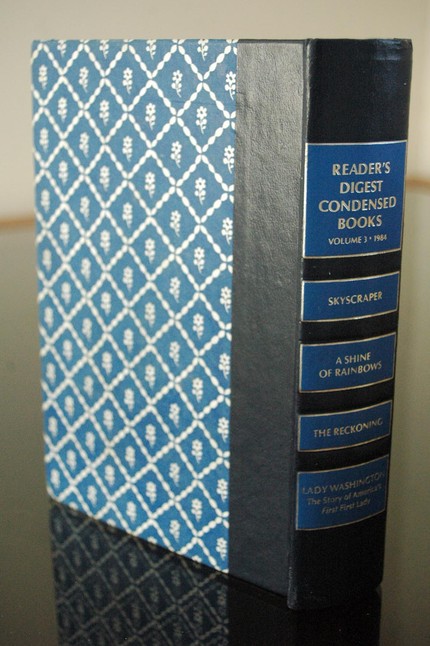
This Etsy seller, as I understand it, uses the virtual remains of books that are crumbling into nothingness as material to create new, hand-bound notebooks. In other words, the material nature of the book is redeemed, and extended.

“Abstract Beeswax Book,” from Tocornal Design. It’s made from thread, beeswax, and “pages from 7 different sources.” Via Design*Sponge.

Garth reminds me of the work of Thomas Allen — I think I’ve highlighted it in the past, for different reasons, but I’m definitely a fan.
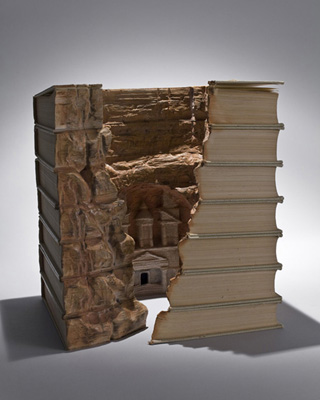
And Zeke points me toward the work of Quebecois artist Guy Laramée, “who sandblasts encyclopedias and then gives them evocative names.”




 "
"





























 Kim Fellner's book
Kim Fellner's book  A
A